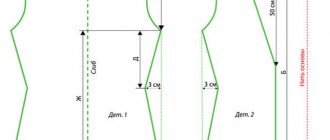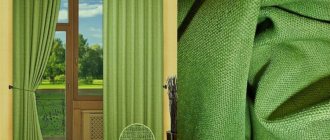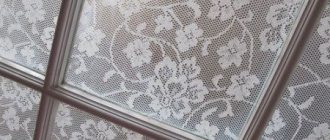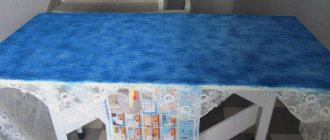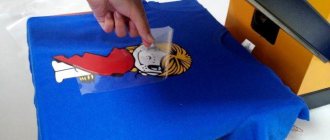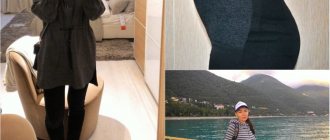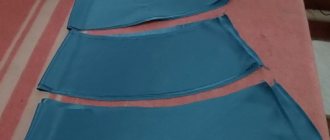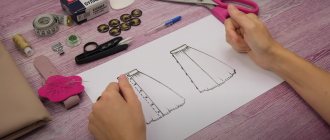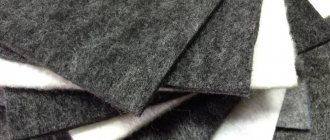Tulle is a thin drapery used to decorate windows. This is a very popular way of decorating both residential and office premises today. Detailed instructions on the topic “We sew tulle with our own hands” will tell you about the main nuances and difficulties of sewing such an item yourself.
Tulle is an essential detail of a classic window.
Sewing tulle with your own hands will be cheap, and the product can be made in an exclusive version.
Briefly about DIY sewing for the kitchen and other rooms
The new tulle drapery looks great in any room. Sewing tulle will not be difficult if you have at least minimal sewing skills, and in some cases, a suitable pattern.
Many people are not familiar with the technique of sewing tulle, although even a person ignorant of sewing curtains can complete the simplest model.
If you have beautiful fabric, then it is quite possible to master sewing tulle with your own hands.
First you need to decide on the fabric - transparent, translucent, dense, it can be:
- organza;
- chiffon;
- veil;
- net;
- muslin.
The color of the material must be selected so that the finished item fits well into the existing design of the room. In addition to textiles, you will need curtain tape, loops or eyelets of a diameter suitable for the cornice, and threads to match the fabric.
The curtain model for sewing should be chosen strictly in accordance with the style direction of the room.
Focusing on the characteristics of the current interior design, you should clearly decide on the color of the tulle.
What kind is it?
Tulle fabrics were born generally by accident. At the end of the 18th – beginning of the 19th centuries. There was rapid mechanization of the textile industry. Completely new products appeared that were impossible to produce manually. One of them was knotless fishing nets, which offered much less resistance to movement in the water. At a time when fishing was still carried out from sailing schooners and lugers, this was very significant and in demand.
The early days of what is now called post-industrial or consumer society were regularly rocked by crises of overproduction. Small enterprises, in order to survive, mastered the production of thin small knotless mesh from cheap cotton yarn and offered it for household purposes instead of expensive silk transparent fabrics. It is believed that weavers in the French city of Tulle first thought of this, hence the name.
The novelty was to the taste of consumers, and soon all translucent curtain fabrics began to be called tulle, and curtains and curtains made from them - tulle. The names of tulle fabrics can be masculine or feminine, and tulle curtains are used in the language either way. Therefore, in order to understand what is going on in publications on tulle, you need to read the context. Usually tulle (m) means tulle fabric, and tulle (m/f) means tulle curtain.
Note: Similar confusion also exists with veil and veil. Voile (m) is definitely fabric, and veil (m/f) is either the same fabric or a garment made from it.
Examples of sewing tulle with your own hands, types
How to sew tulle yourself? To do this, it is better to turn to numerous master classes or relevant literature on cutting and sewing. First, measure the width of the window, the height from the floor to the cornice. The fabric is taken one and a half to two times more in width, and in length - just enough to make seam allowances.
The first step is to correctly calculate the length and width of the fabric.
A simple idea for sewing tulle.
- First, you need to process the top and side edges with a double hem, stitching five to seven mm. from everyone. The bottom is bent by 10-15 mm.
- Sew the curtain tape on top with a double seam and carefully pull it so that the product fits exactly the size of the cornice.
- The curtain is tried on the cornice and, if necessary, adjusted in length and width, after which it should be ironed with a not too hot iron.
- Now the curtain can be hung.
The height of the ceiling is measured from the eaves to the floor line.
When attaching curtain tape, extreme care should be taken to ensure that the stitching never crosses the tension cord.
Advice. From leftover fabric, including old fabric, you can make original decorations for curtains - flowers, butterflies, bows, decorative tiebacks, etc.
Curtain models
For children's apartments, it is worth choosing a curtain fabric in light colors. The perfect option is a one-color curtain decorated with images of characters. The multifunctional color of tulle is white, but you can also choose a shade of beige or cream.
Choose the style to suit your taste. Use applique, decorate with beads, add a fancy lambrequin. If the room is for a girl, then feel free to use ruffles and bows. If this is a boy’s room, then abstract figures, cosmic bodies, and images of cars are more appropriate. By decorating the curtain with appliqués from cartoon series, any child will be delighted with the room.
A wonderful place where all the guests in the house gather must be perfect. Light, transparent fabrics are suitable for such a room. Straight curtains look great in their natural form, in warm colors. It doesn’t have to be an ordinary hanging fabric; it can be decorated with tasteful accessories.
Sewing elegant tulle for the living room is just as easy. The matter of improving curtains in a room of this kind must be treated with attention. The room should look luxurious and elegant. That is why it is necessary to decorate the curtains yourself so as not to go overboard with accessories.
You can use crystals, tassels or picturesque pendants to decorate plain curtains. Graceful flowers, made independently from a smooth ribbon or from pieces of leftover tulle fabric, are suitable as an element for drapery.
Decorated pendants will be molded favorably, giving a special ambiance. Don't be afraid to create your own individual style, highlighting your uniqueness.
How to sew folded tulle - instructions, examples, photos
Here is an option on how to sew tulle most beautifully, decorating it with folds. The latter can be done in several ways.
Modern stores offer customers a wide range of fabrics and decorative accessories.
By showing imagination and a little craftsmanship, you can sew a stunning curtain for window decoration.
- By hand - it is advisable that there be three times more fabric than the length of the cornice. That is, when there are three cornices, nine meters of tulle will be needed. The most commonly used is the triple fold. This is done like this: measure 7 cm, make a fold to the left, fasten it, measure 3.5 cm, bend the fabric to the right, after another 7 cm - down to the left, after 3.5 cm, after 7 cm - up to the left, after 3.5 cm, up to the right, etc. Each bend is carefully secured. If there is a little less textile, then the folds are made at a distance from each other - in this option the tulle is laid in “loops”.
If you take a light fabric as a basis, for example, a fashionable material, organza, you can sew a beautiful tulle curtain.
- On curtain tape - in order to correctly lay the tulle, you need to know the gathering factor of a particular tape, which you should ask about at the time of purchase. The fabric is simply sewn to the tape, after which you pull the strings - the curtain will fall into beautiful folds. Design options here are chosen based on personal preferences - “glass”, “puffs”, bow folds, etc.
The side threads can be tied and untied to iron the curtains after washing.
Useful tips
You now know how to sew curtains yourself, but it’s worth mentioning a few useful design tips. Even when the main work is already finished, there is no need to throw away extra scraps and pieces. From the leftovers you can make decorations and special fasteners that will help move the curtains in different directions. A section 70 cm long is enough here, no more. It doesn’t matter what was used, veil or organza for curtains. It doesn't matter what the width is. Also, beautiful flowers are made from tulle flaps, which are then sewn to the main fabric. You just need to take into account that the veil is different from organza, it is thinner and it is unlikely that it will be possible to sew a multi-story structure from it.
WATCH VIDEO INSTRUCTIONS
In this regard, you need to use your imagination - the more magnificent the curtain, the more glances it will attract.
How to sew tulle diagonally
Now we sew “oblique” tulle, that is, at an angle. Here we are talking about a curtain, very short in the center and longer at the edges of the window.
Tulle, sewn with your own hands, will become not only a fashionable decoration at home, but also a source of pride for the hostess.
It is important to consider a finish that will ideally suit the design of the room.
The window and cornice are measured in length and width, then the fabric is folded in half on a flat surface and cut according to the pattern into an arch or corner. The outer sides are folded up, the inner edge is decorated with bias tape - contrasting or in the same tone as the tulle. The upper edge is attached to a curtain tape or decorated with small folds.
It is not recommended to sew curtains with a large number of decorative additions for the kitchen.
Bias tape
This method is most often used to process embroidered fabric or mesh tulle.
For this you will need a special foot, which comes with your sewing machine.
It can also be purchased at sewing stores. A snail foot would also work. The bottom of the curtain is trimmed evenly, ironed and folded when sewing (the edge of the fabric is tucked into the foot).
Bias tape can be purchased at the store. This is an applied tape with pre-fitted allowances; it can serve a decorative function (for example, satin trim). It's easy to sew on.
- Pin the binding to the bottom edge of the tulle with sewing pins. Check the seams. Sew with a straight stitch.
How to make beautiful folds and assemblies with your own hands
Ruffles on tulle look beautiful in almost any arrangement. There is a quick option for creating a small assembly that requires accuracy and a trouble-free sewing machine. It is important here that the thread does not get tangled during sewing, the stitching is even and continuous, otherwise the appearance of the product will be greatly affected.
When cutting the product, the functional purpose of the room is taken into account.
Sewing tulle with your own hands can be flawless if the preliminary measurements are taken without errors.
The process of work is very simple: the fabric is folded twice by two to four cm, a line is laid a centimeter from the edge, and another one is laid one centimeter from the other edge of the hem. The thread is not secured at the edges, leaving long tails. When both stitches are completed, you need to pull the loose ends of the threads, evenly distributing the folds. When the process is completed, another stitch is made between the top and bottom stitches - there is no need to tighten it.
In order for the finished product to beautifully frame the window opening, the tulle must be of sufficient length, reaching the floor.
Preparatory work
Before work, cover the table with a cotton cloth - this will reduce the sliding of the curtain on the surface.
It is recommended to hem very thin material on tissue paper. After completing the stitch, the paper simply comes off.
Before you start working on your sewing machine, stitch a little on a small unnecessary piece of tulle. If necessary, adjust the stitch length and thread tension. The seams are made with a straight stitch with an average step length (3-4 mm).
Tulle for the kitchen: design options, how to sew beautiful tulle for the kitchen
The question of how best to make tulle for the kitchen with your own hands interests many housewives. It is important to consider that this is a room where the likelihood of drops of fat getting on the textiles and food stains appearing is excessively high, so the fabric should be easy to wash.
To ensure that your hand-sewn tulle beautifully frames the window opening, it is recommended to trim its edges with lace.
For the same reason, you should avoid excessive decoration and numerous folds on the curtain, giving preference to simpler forms.
Any colors are acceptable, but juicy and appetizing colors are preferred.
Stylish component
When the technology for sewing curtains is determined and the fabric is selected, the question of aesthetics arises. Everyone wants home to be a place where it is always cozy and comfortable. It is textiles, in particular curtains, that add coziness to any room. So which ones should you choose?
If the interior is saturated with bright colors, you should pay attention to colored curtains that will complement the existing design. You can take a color that is already present in the interior, but choose a softer and more pastel shade. Remember that any shades differ in warmth, and a cooler shade of a color already present in the interior will look inharmonious. When choosing colored tulle and bright curtains, you need to focus on filling the room with light. In a bright room, colored tulle looks vibrant and bright, but if there is little sun, it will seem heavy and dark.
You may also be interested in: Which fabric to choose for tulle?
The most classic option in the style of minimalism is white organza fabric. You can choose curtains of any color to match it. But don’t think that choosing white organza is easy. It can also be cool white, ivory or pearlescent. Each shade will look different and suit completely different interiors. You should not try to combine several shades of white; this task is extremely difficult, and not even every professional designer will be able to choose the combination correctly.
Whatever fabric you choose, whatever color and style you choose, now you can sew tulle with your own hands.
Save
Examples and photos of tulle design
The original folded tulle in the photo from the Internet looks luxurious - such a voluminous product is suitable for Baroque, Empire, and classical interiors. The curtain for the bedroom is made more textured than for the kitchen.
The upper part of the canvas is treated with braid, which will create a beautiful drapery.
A combination of two or three colors, smooth and textured fabrics at the same time is very popular. The children's room is decorated with non-staining fabrics, decorated with bright prints with images of favorite cartoon characters and fairy tales.
For a child's room, it is worth purchasing curtain fabric in bright, but not overly variegated tones.
The ideal option is a plain curtain, decorated with a delicate pattern.
About fabric colors
Tulle fabrics are translucent. Because of this, the psychedelic effects of their colors are enhanced. As a result, large plain fields of orange are unacceptable in tulle, as well as combinations of it and yellow with blue and light blue. Such colors can cause a short-term emotional uplift and a surge of strength, but their regular contemplation has, without exaggeration, a destructive effect on the psyche. Psychologists call such combinations the colors of madness. However, tulle decor using yellow and orange is appropriate in work spaces that give a depressing effect, for example, in a cramped kitchen. However, in this case, the main color accents should be red and light green, see for example. track. rice.:
Tulle pattern in the kitchen
More about old stuff
Another good way to give new life to old tulle is to turn it into an arched curtain for the kitchen. Arched tulles do not block the window much, but provide sufficient area for color decor. For arched tulle, an old one with a completely frayed bottom and top will do. The pattern of arched tulle for the kitchen is shown in Fig.
Tulle arch pattern for the kitchen
Features of care
Since mesh curtain fabric is a kind of “dust collector”, caring for it involves frequent regular washing. It is performed according to the following rules:
Curtains in the kitchen need to be removed and dusted. This will allow you to get rid of dust. Soak the fabric in warm soap or soda solution. Hot water is strictly prohibited, as it causes the fabric to shrink.
Water temperature - no more than 40°C. The volume of water is determined on the basis that it will completely cover the tissue. Soaking time does not exceed 12 hours, for example, overnight.
Lye and wool fabrics should not remain in water for a long time, so the required time is 2-4 hours. The consumption of powder is 2 times less than when washing. For bleaching, you can prepare a soap-soda solution: add a handful of salt and powder to a basin of water. You can ensure gentle washing in an automatic machine using a pillowcase in which the curtain is folded. You need to wash at a temperature of 30-40°C, setting the minimum spin speed. Mesh kitchen curtains are carefully straightened and hung on a curtain rod while damp. Such curtains do not need ironing, but they can be steamed.
If the laundry gets wet for a very long time, it turns sour and becomes completely saturated with an unpleasant odor.
WATCH VIDEO INSTRUCTIONS
Mosquito net made of cable channel
In small towns, factory-made components for window sides may not be available for sale, or the home craftsman may not know the addresses of these stores. In this case, do-it-yourself mosquito nets can be made from cable ducts that are guaranteed to be available on construction markets.
The budget for the craft is 300 - 400 rubles, all operations initially take 2 hours, subsequent mosquitoes are created twice as fast.
The manufacturing technology is as follows:
- cut - unlike the previous case, the edge is cut in a miter box at 45 degrees assembly - the greatest strength is ensured by the connection with metal corners with rivets
- fixation of the canvas - the mesh is snapped into place by the counter strips of the cable channels around the perimeter, starting from the short side
Installation on site is similar to the previous case. If necessary, brackets can be made independently from scrap materials:
- aluminum strip PVC profile piece
- two corners connected by reverse sides
To prevent the cable channel plastic from bursting at the moment of tension, the riveter is located on the plastic side, and the crushable part of the fastener is on the metal plate side. The diameter of the drill when making a hole is indicated on the packaging of the rivets or is selected according to the table.
By making mosquito nets with your own hands, the user ensures maximum integration of the structure into the size of the existing opening. The comfort of use increases, there are no cracks through which insects can penetrate.
Decorating curtains
In addition to tailoring, there are several options for making tulle more beautiful. You can choose one or more depending on the desire and design of the room.
- side grabs;
- decorative knot or bow;
- gathering in the middle with a ring or garter;
- for closed windows there is an interesting option: the tulle is attached not only from above, but also from below to the frame so that it does not dangle.
Decorating curtains with a knot
Thus, it is quite possible to sew tulle yourself, there is nothing complicated about it. The main thing is to have desire, fabric and a sewing machine.
Advantages
Curtains made from mesh have many advantages:
- They do not delay and gently diffuse sunlight. Therefore, they are ideal for dark, small rooms with north-facing windows. Even the fine mesh fabric allows fresh air to pass through perfectly. They are easy to wash.
The disadvantage is that mesh curtains in the interior attract and collect dust. And how could it be otherwise, if dust particles move along with gusts of air through the cells. The smaller the cells, the more dust is retained on the fabric.
Variety of colors
Mosquito net from factory impost
If there are stores in the city that sell components and fittings for PVC windows, it is easier to make mosquito nets with your own hands from these elements. In this case, the budget will be maximum; however, the products will still cost less. For homemade mosquitoes you will need a kit:
- fabric cord of the required diameter handles fasteners (Z-shaped brackets)
The dimensions of the structure are taken taking into account the size of the opening - the internal dimensions of the mesh correspond to it. The manufacturing technology looks like:
- cut of the impost - two vertical, two horizontal blanks, for greater rigidity the middle jumper can be used from the same material assembly - the frame is assembled using corners and extensions wrapping - the mesh is placed on the frame, pinched inside the groove with a cord on one short side, then the rubber seal is tucked all over around the perimeter, the edge of the cord, the canvas is cut off; installation – the structure is pushed into brackets fixed on the outer frame
The advantage of the method is the factory quality of the elements, the presence of original handles, corners, and connectors. The impost is cut using a hacksaw; thanks to special elements, the cut is straight everywhere. The mosquito net does not differ in design, quality, or service life from the factory modifications.
Difficulties in cutting yourself
The self-cutting master class is conducted without basic knowledge, since there are not many difficulties.
- When placing the pattern, pin it in place so that the fabric does not move.
- Soap is not visible on all fabrics; they are used to trace the pattern, so washable felt-tip pens or chalk are used.
- They forget about allowances; they are needed so that the length of the product does not shorten.
- Use tracing paper; it is better to pin it to the material.
- Before cutting the main one, it is better to make a sketch on unnecessary fabric to make sure that you sew everything correctly.
Loops
Wide short stripes are made from the same or additional contrasting fabric, which are sewn in the form of loops evenly along the upper edge of the curtain. The loops can be either stitched or fastened with large decorative buttons sewn to the curtain. Another option would be to tie a loop into a bow.
